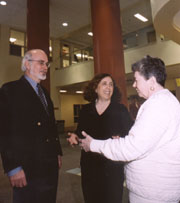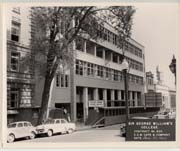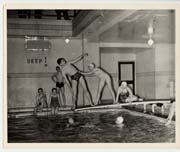
Tom Swift, Nancy
Marrelli and Lynne Prendergast standing in the lobby of the “new”
Norris. Tom was Director of Admissions of Sir George, then of Concordia,
and is now an international recruitment advisor to the John Molson School
of Business. Nancy worked in the library in the Norris, and says she
met her husband there; she is now Concordia Archivist, and kindly provided
the accompanying photos. Lynne worked in Admissions in the Norris from
1964 to 1992, earning three degrees over the years; she is now Registrar
of the university.
Photo by Christian
Fleury

The exterior
of the Norris, On Drummond St., looks much the same as when it was built
in 1956.

The Sir George
Bookstore

Sir
George students had the use of the YMCA swimming pool.
Photos courtesy
of Concordia Archives.
|
by Barbara Black
The YMCA’s Norris Building, on the east side of Drummond St. between
St. Catherine St. and de Maisonneuve Blvd., has just undergone a $20-million
facelift.
Nobody could be happier than the Concordians who remember studying, teaching
or working there when the Norris was the home of Sir George Williams University,
one of Concordia’s founding institutions. Indeed, Sir George Williams
College started with night-school classes given by the Y, the Young Men’s
Christian Association, in its 1912 neo-classical building and its 1936
extension.
Built next door to these buildings in 1956 at a cost of $3 million, the
Norris was homely and functional, designed specifically to house the mushrooming
enrolment of Sir George.
By the 1960s, the tie with the Y was loosening, but students still made
good use of the pool and the chapel. In 1964, the new building was named
after Kenneth E. Norris (1903-1957), the principal of Sir George from
1936 to 1956. Under his leadership, the College grew rapidly, granting
degrees in 1936, and obtaining its university charter in 1948.
In 1966, when the Henry F. Hall Building was built, SGWU severed its financial
ties with the Y, but the legacy of education as a life-long process, long
upheld by Kenneth Norris, had been firmly established.
Space in the Norris continued to be rented by Concordia. The library was
the last to leave, in 1992, when the J.W. McConnell Building opened.
Writing in the Gazette last weekend, architect Susan Bronson said that
the Norris “was an unequivocal statement of its time and a symbol
of the Montreal Y’s progressive educational role in the 1950s.”
She went on: “From an environmental perspective, the reuse of the
Norris Building represents a more ecologically sound approach than a new
building. . . . Although much of its interior is unrecognizable, those
who knew it before will recognize certain qualities, such as its abundant
natural light and some finishes, like the original terrazzo floors.”
She noted that the Y, once white, English-speaking and male, has for many
years now been as eclectic as any institution in Montreal.
This is the oldest YMCA branch in North America, and this project caps
its 150th anniversary. Along with state-of-the-art fitness equipment,
its renovation includes some poignant touches of history, such as the
chapel, a little gem built in 1931 and long closed to the public, which
has been reconstructed in the newly renovated building.
Our hearty congratulations to the Y and all its members.
— With information from Jane Shulman.
Memories
We invited some Concordians to share their memories of the Norris Building:
Professor Sandra Paikowsky
I was a fine arts students in the Norris Building, although most of our
classes were held in the building at the northeast corner of Drummond
and de Maisonneuve in the mid-1960s.
My main Norris memory is of working in the library. Having come from the
Maritimes, I had never seen a library with so much art material —
it was a treasure trove. I think that the library, almost more than my
classes and professors, motivated me to become an art historian.
This experience was all the richer as I worked at the circulation desk
part-time for a year and then got the job of my dreams as I ran the separate
periodicals room at night for two years.
Since very few students showed up in the evenings, I had the place and
the time to myself. As a result, I read every art periodical and other
publications in the humanities, providing myself with a superb education.
I look back on that experience with nostalgia and envy, particularly because
of the fact that for four evenings a week I had the luxury of reading
simply for the pure pleasure of learning.
Professor Clarence Bayne
Guys wandering through the office corridors with nothing on but a bath
towel, thinking that they were on their way to the shower. Some of us
wonder if they had genuinely descended a level too low from their YMCA
overnight room. And then there were the transparent objects that came
to rest on our window sills, on their descent from the rooms above us.
The curtains in our offices were held together by the dust that had gathered
for years. The Drummond St. elevator that worked less frequently than
the escalators in the Hall Building do now. offered service at last resort
if you found the winding staircase a challenge. Your flight along the
corridor past the Registrar and Accounting services took you, mercifully,
into the Stanley Tavern, where, after many drafts, the mind was freed
from the oppression of Erudites.
From these humble spaces, Concordia set its foundation firmly on the education
of the less privileged: the city’s working class, the immigrants
and domestics.
The Black Theatre Workshop of Montreal had its beginnings there. For a
year, free of charge, it used Birks Hall for teaching its members dance,
movement, speech, and acting. Its first major public performance, How
Now Black Man, was rehearsed there. The Negro Theatre Guild held several
performances there.
Good Gad! Thirty-three years ago, I was attending a meeting of the Trinidad
and Tobago Association in the Norris Building when I got the news that
my daughter was born. Back then, we were still using the slide rule and
Pascal approximations for inverting a matrix. Sitting here in this digital
moment, I can’t imagine that time has gone by, it seems, so imperceptibly.
Professor Stephen Scheinberg
I came to Sir George Williams in 1962, and have many memories of the Norris,
including the “faculty-and-staff-only elevator” and being asked
for my i.d. to ride it. There were the long, hectic registrations in Birks
Hall, with the lines stretching on forever.
Later, there was [writer] Hugh MacLennan, who lost his office at McGill
but who took up our offer of an office there. Others who passed through
were [architecture historian] Phyllis Lambert and former governor-general
Romeo LeBlanc, both of them teaching on a part-time basis.
I could go into the odd incidents in the men’s washroom which adjoined
the YMCA, but you have a family readership, so no details will be given.
One should not ignore the convenient location of the building. On the
Stanley St. side in the 1960s, one could find a marvelous Hungarian restaurant
[the Pam Pam] with mouth-watering ludlab (chocolate nirvana). There was
also a radical bookstore, appropriate to the Sixties, and later, a faculty
member opened a bar in that location.
On the corner of St. Catherine and Drummond some of us found the best
croissants at Aux Délices, and others, mainly in the English Department,
had a friendly watering hole upstairs at the Yacht Club. There was the
library confined to the top floor, where the librarian seemed most interested
in zealously guarding her collection. Unforgettable characters included
English Department chair Neil Compton, confined to a wheelchair, who made
a deep impression on many of us due to his intellectual depth and engaging
personality. There was the History Chair, Ed McCullough, who ranted about
the First World War and British responsibility while keeping his eyes
fixed on those women with ample bosoms. Registrar Donald Peets was a large
presence who never seemed to talk when he could bellow.
Student politicians could be found in the basement, where some of them,
even then, found interesting ways to divert student funds.
|
|
|



